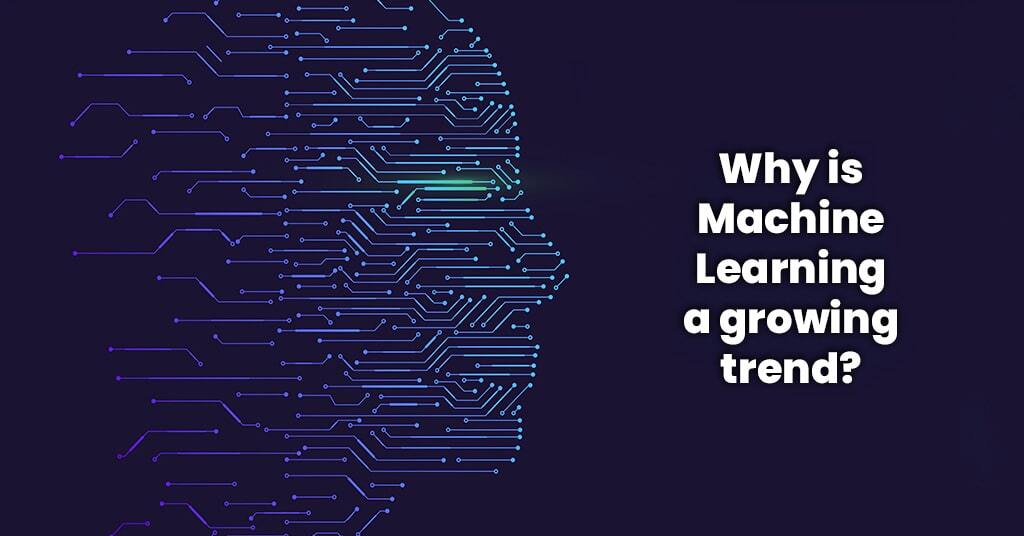Why is machine learning a growing trend?

Alexa Trachim

What we know about machine learning right now it’s just the tip of the iceberg. This technology is developing rapidly and it became one of the most promising trends of 2020. In our article, we will focus on explaining what machine learning is, what it can be used for and what it shouldn’t be confused with.
Table of contents
- What is machine learning?
- How does machine learning work?
- What is the difference between AI and machine learning?
- Machine learning vs. statistical learning
– Operating mechanisms
– Approach to tasks
– Outcome - Machine learning vs. deep learning
- What are the different types of machine learning algorithms?
– Supervised learning
– Unsupervised learning
– Semi-supervised learning
– Reinforcement learning - Neural networks in machine learning algorithms
- What is machine learning used for?
– Search engines
– Email
– Social media
– Financial industry
– Customer care
– Health industry
– eCommerce
– Virtual assistants
– Transportation - Machine learning can be a part of your business
What is machine learning?
Machine learning is the field of science that fuses robotics, statistics and informatics. It is a part of scientific studies that deal with artificial intelligence (AI). The primary purpose of machine learning is to create an automatic system that can continuously improve itself without human interference. The only thing it uses is collected data that is analyzed by it to find specific patterns impossible to spot by people. This way, the machine can learn new things only by analyzing existing information and drawing conclusions out of it.
Machine learning is one step ahead from all previous systems that were used by humans to solve problems and discover patterns. Gavin Edwards, the author of a very insightful Medium article about machine learning, is citing François Chollet, a software engineer and the author of a book titled Deep learning with Python to explain why is that:
“Traditionally, software engineering combined human-created rules with data to create answers to a problem. Instead, machine learning uses data and answers to discover the rules behind a problem.”
That’s pretty self-explanatory. The algorithms that are part of machine learning systems can process enormous amounts of data, and that is not just new data someone needs to put in there beforehand. After it is connected to an engine (think Google), it swiftly checks out every info that is out there and when someone interacts with it, machine learning updates its knowledge and finds new solutions to the current state.

How does machine learning work?
You know now how machine learning works theoretically. But let’s dig deeper and see what the exact structure of it is.
The process of machine learning can be divided into 5 simple steps.
- First, the data that is required to begin the process of learning is gathered.
- Then it is optimized to achieve the best form of information so that learning can be simplified. It also finds the most critical features and reduces dimensionalities.
- The fitting stage is the actual learning state, where the machine’s algorithm analyzes the before formatted data.
- After the previous step, it’s time for testing and evaluation.
- If there’s a need for it after tests, the algorithm is tuned to raise its performance. That means going back to the training stage – we can only know that the algorithm is improved when we go through the process again and see better results.
As you can see, the process doesn’t seem that elaborate or complicated. But it is based on a sophisticated math foundation that emerged in the 19th century. Ada Lovelace, the pioneer in computer sciences, titled the first computer programmer, stated that every phenomenon in the world could be obtained using a correct math formula. Her theory concluded that machines could understand the world without any help from humans whatsoever. With today’s advancement in science and technology, it became real in the form of machine learning.
What is the difference between AI and machine learning?
Artificial intelligence (AI) is a capacious term that includes machine learning, but also other areas of computing where robots, computers and machines can do almost anything. Right now, it is often said that machine learning can be considered a part of AI – but at the same time, it is instead the main component of current artificial intelligence systems. Machine learning is the product of AI evolution throughout the years.
So artificial intelligence is the whole concept, an idea that a machine can be similar to the human brain. With technology, it can be able to identify context, do analytical and creative thinking and understand abstracts that, for a long time, only people could perceive.
Current research is conducting experiments with different types of AI; one of their goals is to find out if machines can develop some kind of self-awareness. Creating human-like robots that understand who they are and what they can do could remarkably change the world we live in. They would help with medical procedures, all kinds of big data analysis, scientific tests and much more. Will that happen anytime soon? Time will tell.
As for machine learning, you already know how it works and you can learn more from the rest of this article. Just remember, that machine learning is a part of all artificial intelligence studies.
Machine learning vs. statistical learning
It seems that machine learning is mixed with lots of similar, yet different things. Another one is statistical learning. These two distinct from each other subtly and often their models can also blend, mostly because machine learning can also work on statistical data.
So what are the distinctions between machine learning and statistical learning?
Operating mechanisms
While machine learning uses algorithms and is highly automated (people are less involved in the process), statistical learning requires human factors and is based on equations. In the first case, a large amount of data is not a problem. The second one includes smaller sets of information.
Approach to tasks
Solving issues using machine learning and statistical learning is quite different. Basically, if you need to build a particular program that will be responsible for an action, each of these systems will have its own direction. Machine learning will be based on an algorithm that can make predictions and classify new pieces of data – other than the original input. Statistical learning will find out dependencies between two factors – like movie preferences of a specific age group. It can help with understanding and stating facts about a concrete phenomenon.
Outcome
And the result is the main difference between those two. Machine learning can predict, while statistical learning gives an insight into the current state. Statistics conclude facts from numbers and pieces of information. If we need to know what the tendencies are going to be in the future, that won’t be helpful. Using machine learning to discover what can be the pattern is much more useful in this case.

Machine learning vs. deep learning
We’ve discussed two concepts that can be similar but have entirely different principles, so know we can break another confusion when it comes to machine learning. It is also mixed with deep learning – which is one of the types of machine learning.
The process of learning is what distinguishes these two methods from each other. In machine learning, we need to provide the data and then define what the computer should focus on – these are called the features. They are inserted into the model that should be the base of learning and producing conclusions.
As for deep learning, we don’t need to set the features – the computer with deal with the data itself. Based on methods and tools that allow it to analyze and organize the information independently, deep learning can conclude its own predictions.
Deep learning is gaining popularity in many industries. It can save lives by detecting ill cells, control objects we use every day and automatically verify objects which is useful in smartphones and self-driving cars. We’re going to discuss how machine learning, including deep learning, can be helpful further in this article.
What are the different types of machine learning algorithms?
Like most things in the world of IT, machine learning can also come in different shapes and forms. Based on a learning algorithm, we can set apart the following machine learning models: supervised learning, unsupervised learning, semi-supervised learning and reinforcement learning. We will take a closer look at each of them to understand how they work.
Why do we even need these various types of machine learning algorithms? Mostly because one algorithm can’t solve every issue. That’s why there are plenty of them and one style of approach to machine learning is usually suitable for doing a particular set of tasks.
Supervised learning
In supervised learning, we provide the machine with examples of past behaviors, cases, events and it predicts what can happen in the future, as well as the factors that influence the outcome.
Supervised learning is often used to build efficient systems that can answer questions and solve issues thanks to data collected in previous cases. It compares pieces of information to find out if something can happen. For example – based on our email history, a supervised learning machine can decide if the concrete message is a spam or not. What’s important is that it needs to know both sides of the problem – so in this case, we need to provide previous emails that are spam, but also the ones that are not.
This model of machine learning is commonly used to explore events that happened in the past. With predictions, it allows us to prevent them (e.g., finding out which cells can be potentially cancerous) or to embrace them (e.g., knowing consumer behavior patterns and preparing marketing strategy accordingly).
Unsupervised learning
What’s the difference between unsupervised learning and supervised learning? In unsupervised learning, the machine is looking for patterns without the predefined feature it is supposed to look for. So it doesn’t answer a particular question, but instead analyzes unlabeled data and finds out what emerges out of it.
This machine learning model discovers conclusions that are not focused on any particular topic so that the outcome can be surprising. The most straightforward case of unsupervised learning is dividing provided pieces of information into groups based on one specific trait. For example, it can classify customers by their shopping history.
When we need to perform a task and a teacher supervises us, it can become more manageable because we get the knowledge on what’s important, where to start and what kinds of behavior we should copy to achieve results. But if we want to do it completely ourselves without supervision – it can get harder, because we have no idea what we should begin with. That is an explanation of supervised learning and unsupervised learning.
And this doesn’t exactly mean that supervised learning is better or more effective. That’s because unsupervised learning is not influenced by anything or anyone – so it can conclude things we wouldn’t even think of. It can discover patterns that are invisible to human beings, so it can be useful when explaining a set of data comprehensively.
Semi-supervised learning
As you can probably guess, semi-supervised learning is a technique that derives from two machine learning methods described above – supervised learning and unsupervised learning. Perfect for significant portions of data, because it can work on a small amount of input data that has a predefined feature and then also with unlabeled data. Therefore, semi-supervised learning can solve more complicated problems than unsupervised or supervised machine learning.
Reinforcement learning
The final machine learning type is reinforcement learning. Less popular than other learning algorithms, it is far more complex and unusual. Simply put, reinforcement learning is based on rewards that are used in training so it can improve itself.
In reinforced learning, an agent provides rewards to teach algorithms what direction they should follow. By observation, this agent can conclude which behaviors should be repeated and which are not desired. To be clear, this is not the same approach as supervised learning because, in reinforcement learning, training algorithms require to be supervised only now and then to reassure them which direction is correct.
The main advantage of reinforcement learning is the fact that it is quite similar to learning abilities people have. The training data doesn’t have to be organized; it can be chaotic as is the world of information in the human brain and outside of it. The data we provide to the reinforcement machine learning algorithm can dynamically change.
Reinforcement learning is often tested on games. The game is full of rich training data and scoring is the type of reward the machine is craving for. So it learns how to beat the game and get the best score by going through it over and over again.
Neural networks in machine learning algorithms
Talking about machine learning algorithms, we need to discuss neural networks. A neural network is a model based on a set of algorithms. But you may already know this term – from biology. Neural networks are present in the human brain. These structures are responsible for processing complex sets of information. And neural network algorithms in machine learning were inspired by them.
Neural networks can be applied to any problem in machine learning, no matter how complicated it is and what type of inputs we provide. We don’t need to teach the machine how to find a solution, like in classic computer programming.
There are many types of neural networks that use different mechanisms inspired by a human brain to train new abilities and use them to get even better. These algorithms are still developed to be even better at processing complex data sets and predict conclusions that can be useful to all humankind.

What is machine learning used for?
Now that we know the classification of machine learning algorithms, the types of data they process and the methods they use to provide inference, now let’s find out what are the real-life examples of using this technology in our everyday lives. What’s surprising is that machine learning is already a part of many services we use without even knowing it.
Search engines
Let’s start with the basics, which is an algorithm of search engines like Google, Yahoo, or Bing. They use algorithms to curate even better results each time we look for something on the internet. Its work is based on our behavior – it analyzes how we respond to the data it shows us and updates its knowledge accordingly. If someone picks one of the first results and spends a long time on the website, the engine will know the result was correct.
Another essential activity we do every single day – checking our inbox. We’ve already mentioned in this article, that machine learning is perfect for detecting spam messages. Spammers can use their seasoned tricks but thanks to self-teaching abilities of the algorithms, they are less likely to succeed. That’s because the machine is continuously updating its knowledge and forms detection and defense solutions against malware messages.
Social media
Social networking platforms are not just sharing and linking applications anymore. Their capabilities are broad – so we can create amazing, personalized content. What’s in it for the social media owners? Of course – advertisement targeting.
Learning algorithms are used for better search results, configuring news feeds, face recognition (did Facebook ever suggested people to tag on your group photo?), recommendations and more. What’s interesting, Facebook also uses machine learning to help people with vision impairments to use the page by describing the details of pictures.
Financial industry
There are plenty of things that can be done using algorithms when it comes to tons of data that is processed in finances around the world. From stock exchange forecasts, through investment opportunities recommended to the clients, to identifying fraudulent transactions. Also, big financial corporations often use machine learning to analyze data they collect and extract conclusions that can be beneficial for their growth.
Customer care
In online customer support, chatbots are becoming more and more popular. That’s understandable – they save time by providing answers to most frequent questions, and they save money by avoiding the cost of hiring an employee. We’ve started with simple bots that needed to be provided with information before and could speak only by using precise patterns. Now with algorithms, they became way more advanced.
Health industry
Using algorithms to diagnose different types of cancer is much easier than doing it manually. The machine only needs a small piece of data – for example, slides with cases of infected cells – to compare it with the new record and determine if it actually has cancer or not.
eCommerce
Who has never been in this type of situation? You browse for new slippers on Google and suddenly, the advertisements on your social media accounts and websites you visit are all about shoes, discounts, best stores to sell them online and other related info. Well, that’s the algorithms doing their jobs. And because we have lots of online retail companies that offer hundreds of products, delivering tailor-made ads would not be possible without technology support.
Algorithms are also responsible for product recommendations, which are a part of the after-sale experience.
Virtual assistants
Smart speakers like Amazon Echo, as well as personal assistants in our smartphones (Siri, Google Now), are using machine learning to provide better answers, based on our previous requests. Thanks to the algorithms they use, we can easily set and check our schedules and alarms, find out what’s the weather forecast for the upcoming days and get insightful information about a topic that we are interested in.
Transportation
When using Uber, you get the time and cost estimation in the app. And machine learning predicts what will be the price for a ride by forecasting the demand for Ubers at the moment. Also, algorithms can tell us how long we will be stuck in traffic, thanks to conclusions about road difficulties based on previous similar situations.
Machine learning can be a part of your business
Machine learning is a growing trend – there’s no doubt about it. Many algorithms can be used to achieve different goals and answer different business needs. Data analysis, predicting impact and results of future situations, finding answers to questions that are complex and require lots of info to be comprehensive – you name it. We think that more and more companies will have to use algorithms in their daily operations – because of digitalization and growing pools of data we produce every day.
If you’re looking for a reliable business partner that will help you to implement machine learning into your operations – contact us at itCraft. We’ll gladly help you with every project – whether it is a startup product or a complex system for an expanding enterprise. Let’s work together with this fascinating technology that machine learning truly is. We are sure it is the technology of the future that will constantly grow to improve. Don’t hesitate to provide it to your company.
Read also:
What is blockchain? – a basic guide
What is a cloud application?
How much does it cost to make a booking type app?
19 Apps built with Flutter Framework





